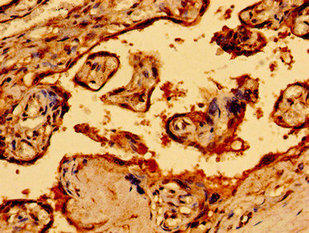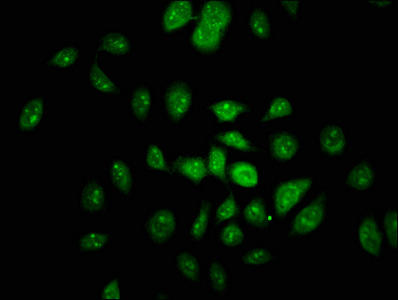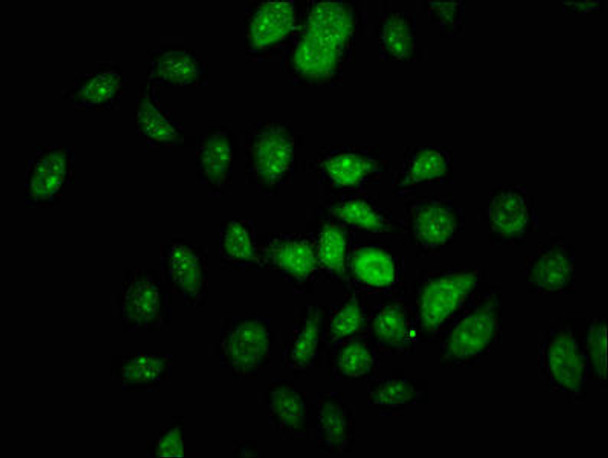Description
NF1 Antibody (PACO54018)
The NF1 Antibody (PAC054018) is a polyclonal antibody designed for research involving the NF1 protein, a tumor suppressor that plays a crucial role in regulating cell growth and differentiation. This antibody, produced in rabbits, exhibits high reactivity with human samples and has been validated for use in Western blotting applications. By specifically binding to the NF1 protein, this antibody enables researchers to detect and analyze NF1 expression in various cell types, making it an ideal tool for studies in cancer biology and neurofibromatosis research.NF1, also known as neurofibromin, functions as a negative regulator of the Ras signaling pathway, which is involved in cell proliferation and survival. Mutations in the NF1 gene lead to the development of neurofibromatosis type 1, a genetic disorder characterized by the formation of tumors in the nervous system.
Understanding the role of NF1 in tumorigenesis is essential for developing targeted therapies for neurofibromatosis and other related conditions.The NF1 Antibody (PAC054018) offers researchers a valuable tool for investigating the function of NF1 in normal and diseased states, providing insights into potential therapeutic strategies for neurofibromatosis and other Ras-related disorders. Its high specificity and sensitivity make it an essential reagent for studies aimed at unraveling the molecular mechanisms underlying NF1-mediated tumorigenesis.
| Antibody Name: | NF1 Antibody (PACO54018) |
| Antibody SKU: | PACO54018 |
| Size: | 50ug |
| Host Species: | Rabbit |
| Tested Applications: | ELISA, IHC, IF |
| Recommended Dilutions: | ELISA:1:2000-1:10000, IHC:1:20-1:200, IF:1:50-1:200 |
| Species Reactivity: | Human |
| Immunogen: | Recombinant Human Neurofibromin protein (655-892AA) |
| Form: | Liquid |
| Storage Buffer: | Preservative: 0.03% Proclin 300 Constituents: 50% Glycerol, 0.01M PBS, pH 7.4 |
| Purification Method: | >95%, Protein G purified |
| Clonality: | Polyclonal |
| Isotype: | IgG |
| Conjugate: | Non-conjugated |
 | Immunohistochemistry of paraffin-embedded human placenta tissue using PACO54018 at dilution of 1:100. |
 | Immunofluorescence staining of A549 cells with PACO54018 at 1:100, counter-stained with DAPI. The cells were fixed in 4% formaldehyde, permeabilized using 0.2% Triton X-100 and blocked in 10% normal Goat Serum. The cells were then incubated with the antibody overnight at 4°C. The secondary antibody was Alexa Fluor 488-congugated AffiniPure Goat Anti-Rabbit IgG(H+L). |
| Background: | Stimulates the GTPase activity of Ras. NF1 shows greater affinity for Ras GAP, but lower specific activity. May be a regulator of Ras activity. |
| Synonyms: | Neurofibromin (Neurofibromatosis-related protein NF-1) [Cleaved into: Neurofibromin truncated], NF1 |
| UniProt Protein Function: | NF1: a Ras-GAP, highly expressed in developing neural cells. Possesses tumor suppressor activity, presumably by virtue of its GTPase activating domain. Neurofibromin is phosphorylated in response to EGF in CNS cells and cell lines. Defects in NF1 are the cause of type 1 neurofibromatosis (NF1), Watson syndrome, and familial spinal neurofibromatosis. NF1 is one of the most frequent autosomal dominant diseases. Four alternatively spliced isoforms have been described. |
| UniProt Protein Details: | Protein type:Tumor suppressor; GAPs, Ras; GAPs; Nucleolus; Motility/polarity/chemotaxis Chromosomal Location of Human Ortholog: 17q11.2 Cellular Component: membrane; axon; dendrite; cytoplasm; nucleolus; nucleus Molecular Function:protein binding; phosphatidylethanolamine binding; phosphatidylcholine binding Biological Process: negative regulation of Rac protein signal transduction; neural tube development; negative regulation of MAP kinase activity; Schwann cell development; extracellular matrix organization and biogenesis; collagen fibril organization; positive regulation of apoptosis; heart development; negative regulation of transcription factor import into nucleus; negative regulation of neuroblast proliferation; regulation of glial cell differentiation; positive regulation of adenylate cyclase activity; negative regulation of neurotransmitter secretion; skeletal muscle development; adrenal gland development; forebrain morphogenesis; negative regulation of cell-matrix adhesion; regulation of synaptic transmission, GABAergic; myelination in the peripheral nervous system; camera-type eye morphogenesis; induction of apoptosis via death domain receptors; negative regulation of fibroblast proliferation; negative regulation of endothelial cell proliferation; negative regulation of protein kinase activity; positive regulation of endothelial cell proliferation; cerebral cortex development; actin cytoskeleton organization and biogenesis; forebrain astrocyte development; metanephros development; regulation of long-term neuronal synaptic plasticity; negative regulation of osteoclast differentiation; phosphoinositide 3-kinase cascade; wound healing; regulation of cell-matrix adhesion; regulation of blood vessel endothelial cell migration; smooth muscle development; sympathetic nervous system development; positive regulation of neuron apoptosis; visual learning; negative regulation of Ras protein signal transduction; cell communication; negative regulation of cell migration; regulation of bone resorption; negative regulation of MAPKKK cascade; MAPKKK cascade; liver development; regulation of angiogenesis; peripheral nervous system development; osteoblast differentiation; negative regulation of oligodendrocyte differentiation; negative regulation of angiogenesis; pigmentation; spinal cord development; negative regulation of astrocyte differentiation; Ras protein signal transduction; response to hypoxia; artery morphogenesis; brain development; cognition Disease: Neurofibromatosis, Familial Spinal; Watson Syndrome; Juvenile Myelomonocytic Leukemia; Neurofibromatosis, Type I; Neurofibromatosis-noonan Syndrome |
| NCBI Summary: | This gene product appears to function as a negative regulator of the ras signal transduction pathway. Mutations in this gene have been linked to neurofibromatosis type 1, juvenile myelomonocytic leukemia and Watson syndrome. The mRNA for this gene is subject to RNA editing (CGA>UGA->Arg1306Term) resulting in premature translation termination. Alternatively spliced transcript variants encoding different isoforms have also been described for this gene. [provided by RefSeq, Jul 2008] |
| UniProt Code: | P21359 |
| NCBI GenInfo Identifier: | 4557793 |
| NCBI Gene ID: | 4763 |
| NCBI Accession: | NP_000258 |
| UniProt Related Accession: | P21359 |
| Molecular Weight: | |
| NCBI Full Name: | neurofibromin isoform 2 |
| NCBI Synonym Full Names: | neurofibromin 1 |
| NCBI Official Symbol: | NF1 |
| NCBI Official Synonym Symbols: | WSS; NFNS; VRNF |
| NCBI Protein Information: | neurofibromin |
| UniProt Protein Name: | Neurofibromin |
| UniProt Synonym Protein Names: | Neurofibromatosis-related protein NF-1 |
| Protein Family: | Neurofibromin |
| UniProt Gene Name: | NF1 |
| UniProt Entry Name: | NF1_HUMAN |
| Antibodies | ELISA Kits |
| NF1 Antibody (PACO06677) | Human Neurofibromin ELISA Kit |
| Human Neurofibromin (NF1) ELISA Kit |
| Secondary Antibody |
| Anti-HRP Goat Anti-Rabbit IgG (H+L) Antibody (CABS014) |
| Recommended Products |
| Anti-FITC Goat Anti-Rabbit IgG (H+L) Antibody (CABS011) |
| Anti-HRP-conjugated Beta Actin Antibody (CABC028) |
















